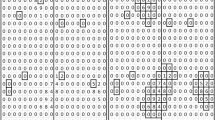Abstract
Adaptive cluster sampling (ACS) has received much attention in recent years since it yields more precise estimates than conventional sampling designs when applied to rare and clustered populations. These results, however, are impacted by the availability of some prior knowledge about the spatial distribution and the absolute abundance of the population under study. This prior information helps the researcher to select a suitable critical value that triggers the adaptive search, the neighborhood definition and the initial sample size. A bad setting of the ACS design would worsen the performance of the adaptive estimators. In particular, one of the greatest weaknesses in ACS is the inability to control the final sampling effort if, for example, the critical value is set too low. To overcome this drawback one can introduce ACS with clusters selected without replacement where one can fix in advance the number of distinct clusters to be selected or ACS with a stopping rule which stops the adaptive sampling when a predetermined sample size limit is reached or when a given stopping rule is verified. However, the stopping rule breaks down the theoretical basis for the unbiasedness of the ACS estimators introducing an unknown amount of bias in the estimates. The current study improves the performance of ACS when applied to patchy and clustered but not rare populations and/or less clustered populations. This is done by combining the stopping rule with ACS without replacement of clusters so as to further limit the sampling effort in form of traveling expenses by avoiding repeat observations and by reducing the final sample size. The performance of the proposed design is investigated using simulated and real data.







Similar content being viewed by others
References
Brown J, Manly B (1998) Restricted adaptive cluster sampling. Environ Ecol Stat 5:49–63
Christman M (1997) Efficiency of some sampling designs for spatially clustered populations. Environmetrics 8:145–166
Christman M, Lan F (2001) Inverse adaptive cluster sampling. Biometrics 57:1096–1105
Di Battista T (2002) Diversity index estimation by adaptive sampling. Environmetrics 13:209–214
Di Battista T (2003) Resampling methods for estimating dispersion indices in random and adaptive designs. Environ Ecol Stat 10:83–93
Diggle P (1983) Statistical analysis of spatial point patterns. Academic Press, London
Dryver A, Thompson S (2007) Adaptive sampling without replacement of clusters. Stat Methodol 4:35–43
Dryver AL, Urairat N, Smith D (2012) Partial systematic adaptive cluster sampling. Environmetrics 23:306–313
Gattone SA, Di Battista T (2011) Adaptive cluster sampling with a data driven stopping rule. Stat Methods Appl 20:1–21
Gattone SA, Mohamed E, Mwangi JW (2013) Application of adaptive cluster sampling with a data-driven stopping rule to plant disease incidence. J Phytopathol 161:632–641
Lloyd M (1967) Mean crowding. J Anim Ecol 36:1–30
Salehi M, Seber G (1997) Adaptive cluster sampling with networks selected without replacement. Biometrika 84:209–219
Salehi M, Seber G (2002) Unbiased estimators for restricted adaptive cluster sampling. New Wealand J Stat 44:63–74
Su Z, Quinn TI (2003) Estimator bias and efficiency for adaptive cluster with order statistics and a stopping rule. Environ Ecol Stat 10:17–41
Thompson S (1990) Adaptive cluster sampling. J Am Stat Assoc 85:1050–1059
Thompson S (1991a) Adaptive cluster sampling: designs with primary and secondary units. Biometrics 47:1103–1115
Thompson S (1991b) Stratified adaptive cluster sampling. Biometrics 78:389–397
Thompson S (1996) Adaptive cluster sampling based on order statistics. Environmetrics 7:123–133
Yu H, Jiao Y, Su Z, Reid K (2012) Performance comparison of traditional sampling designs and adaptive sampling designs for fishery-independent surveys: a simulation study. Fish Res 113:173–181
Acknowledgments
The research by the second author is funded by the National Commission for Science, Technology and Innovation (NACOSTI, Kenya), the Deutscher Akademischer Austauschdienst (DAAD) and the Rhineland-Palatinate research initiative via the Trier Centre of Sustainable Systems (TriCSS). Finally, the authors thank the editors and two anonymous referees for their helpful comments that have further improved the quality of the paper.
Author information
Authors and Affiliations
Corresponding author
Additional information
Handling Editor: Bryan F. J. Manly.
Rights and permissions
About this article
Cite this article
Gattone, S.A., Mohamed, E. & Di Battista, T. Adaptive cluster sampling with clusters selected without replacement and stopping rule. Environ Ecol Stat 23, 453–468 (2016). https://doi.org/10.1007/s10651-016-0348-9
Received:
Revised:
Published:
Issue Date:
DOI: https://doi.org/10.1007/s10651-016-0348-9




